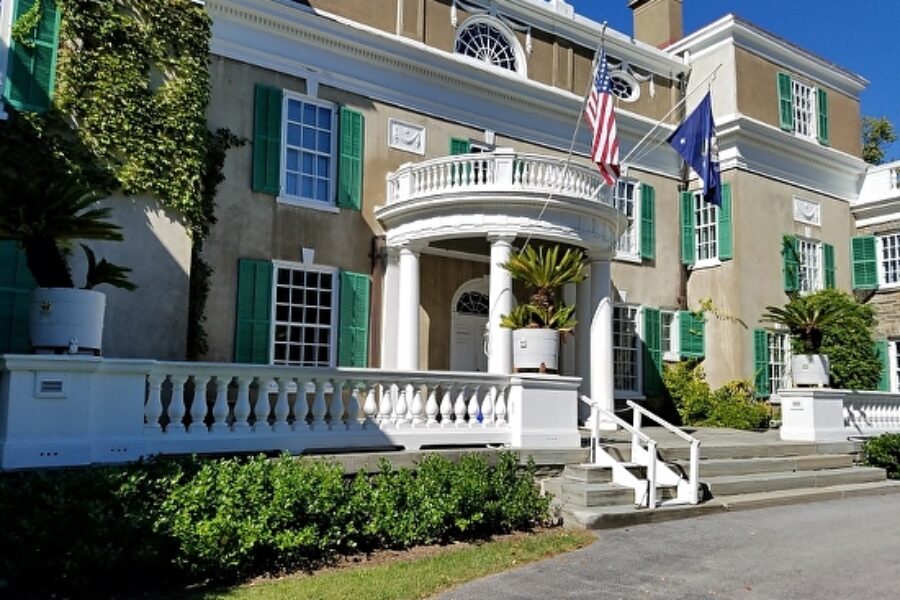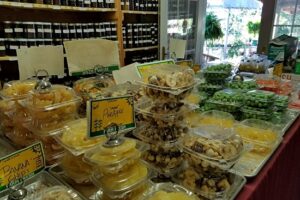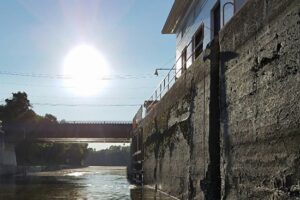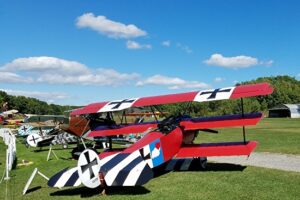They say timing is everything and today we seem to be doing it right.
F.D.R.’s home and Presidential Library have always been on my list of TO DO’s in the Hudson River Valley—actually, this is why we are here. Then I discover the Culinary Institute of America is almost right next door, and I think we HAVE to go. It seems to be a perfect day. F.D.R.’s Hyde Park home, lunch at the CIA, then the library. But I don’t want to rush lunch—reservations are at Bocuse—and I know the library will take forever because I like to read everything, so I dither, trying very hard to make things work.
Finally, I give up and cancel Bocuse; another day.
Standing before the park service representative, we discover we can make the next tour with time to spare. We watch the introductory film and peruse the gift shop—Michael finds a pin, he’s happy—I check out the myriad volumes of books written that have anything at all to do with Roosevelt’s presidency or the time period during his presidency. F.D.R. brought us out of the depression and led us into a war, and thankfully brought us out of that too. There are a LOT of books.
Gathering around a tiled floor map in the visitor’s center, the tour group politely listens as the park ranger begins his spiel. He is excellent. He knows a lot of stuff; he doesn’t sound like a recording. He gets an A. There are fifty people on this tour—that gets a C.


We leave the building, following our guide to the front steps of Springwood, the birthplace, lifelong home, and burial place of the 32nd President of the United States. There is always something new to learn. F.D.R. was a C student in college, achieving his greatest college fame in extracurricular activities. He didn’t finish law school, but he passed the bar. That was enough back then to be a lawyer—maybe it is today too?
When polio attacked him at Campobello at the age of thirty-nine, not only were his legs paralyzed but so was his body from the chest down—even his arms. Sheer will and determination brought back the use of his arms, and swinging his shoulders propelled him forward in his effort to appear to be able to walk. He loved Springwood, but since his mother inherited it upon his father’s death, he only personally owned it the last four years of his life. No wonder he had Top Cottage and Eleanor had Val-kill.
Finally, we get to go into the house—a time capsule. We walk into a huge foyer—all fifty of us—and there we stand, or mill around, trying to be polite, sticking our nose into basically two rooms while keeping our bodies behind velvet corded barriers. The dining room seems quite small, especially for important dinners. Every room is dark—for preservation’s sake, I know. What strikes me as I stand here looking around at all of the art on the walls is that there are no oil paintings—only prints and engravings. I love prints and engravings and feel right at home, but still, I’m surprised.



We are led, twenty-five at a time, up the stairs. It is tight, we are told, so we let one group stick their noses in all of the available, viewable rooms on the second floor while we have a bit of breathing space below. Eleanor’s room is not very exciting; Franklin’s adjacent room, a bit grander. Both wings of the house, upstairs and down, as well as the third floor, are closed to visitors. However, it is nice to see where history was made and where King George and Queen Elizabeth slept when they visited—charming—but a bit of a step down from the palace. I wonder what they thought.





Leaving the house by a back outside staircase, I find Michael sitting on a rustic bench overlooking the invisible Hudson River. I join him, sitting awhile enjoying the sun and the grass and the trees.

Passing by the façade of Springwood once again—sans fifty people—I take a detour, stepping onto the porch of the east wing of the house and look into a darkened window. I see nothing but the bare outline of a desk. Experimenting, I put my phone’s camera against the glass and snap a picture—no flash. I am rewarded with a photograph of Roosevelt’s study where he met with heads of state and where the seeds of the Manhattan Project were both sown and reaped.

On our way to lunch, we walk through the gardens, and I see my grandmother’s yard. Bachelor Buttons. Zinnias. Periwinkles. Such old-fashioned flowers—they speak to me of decades past. I think of Easter egg hunts when I was small.



After lunch, we spend the afternoon in the very first presidential library. We are lost in a world of depression and despair and war and desperation and patriotism and triumph and death and sadness—a nation in mourning. And my head spins.










Leave a Reply
Your email is safe with us.